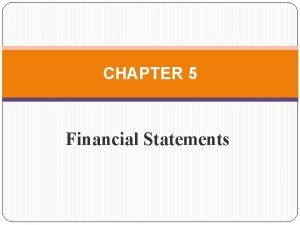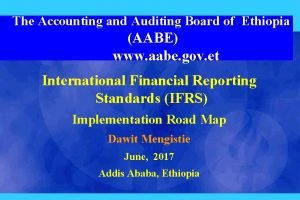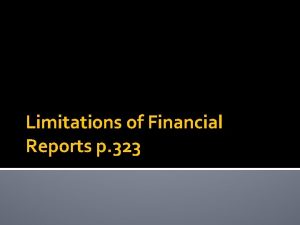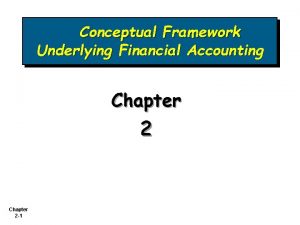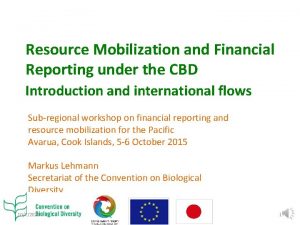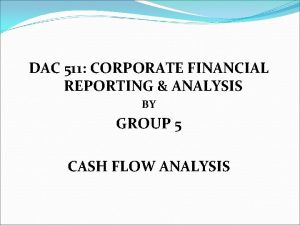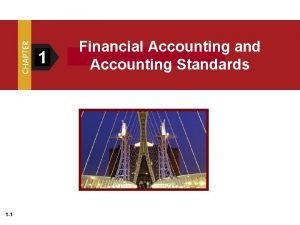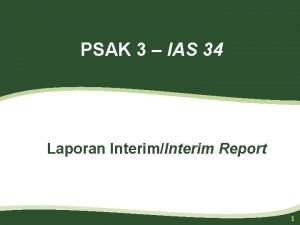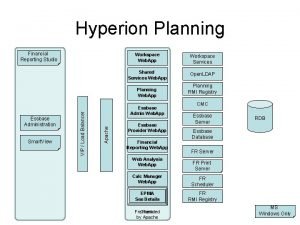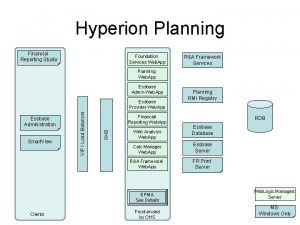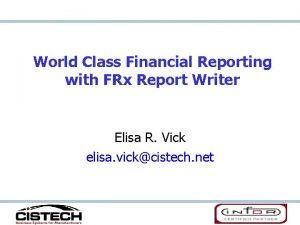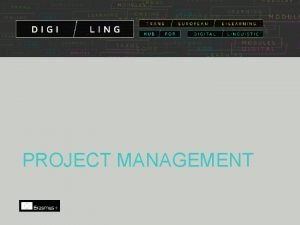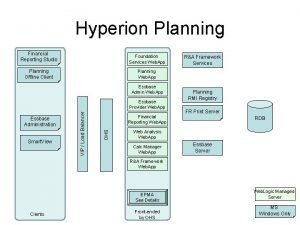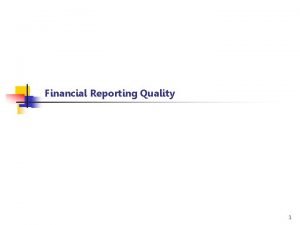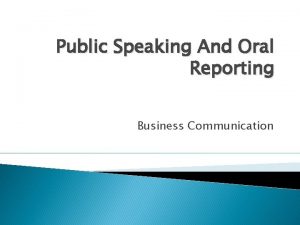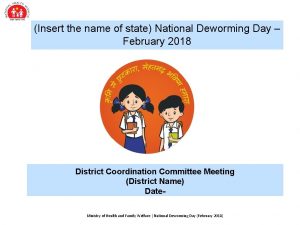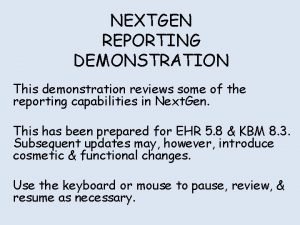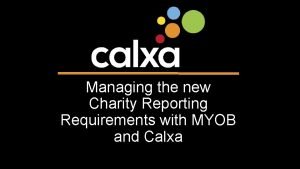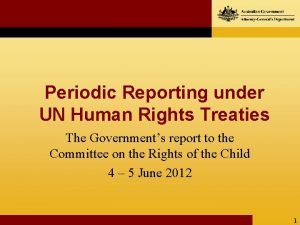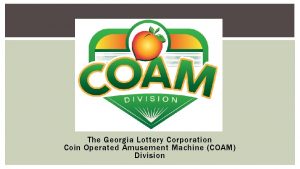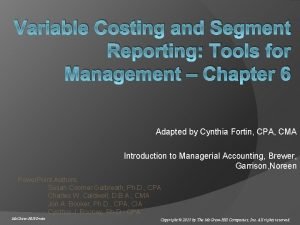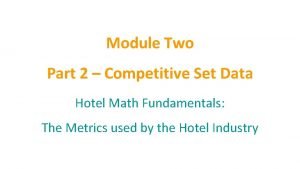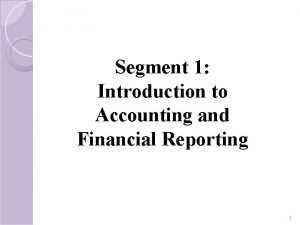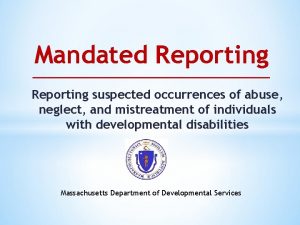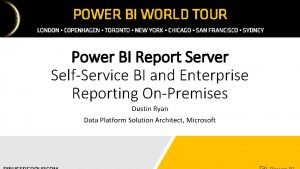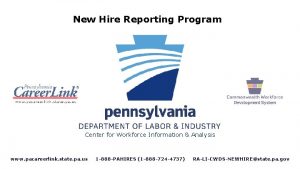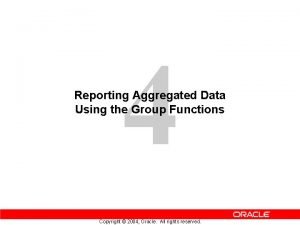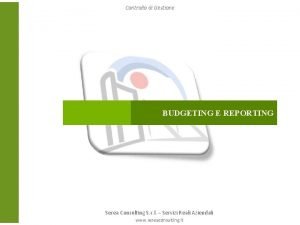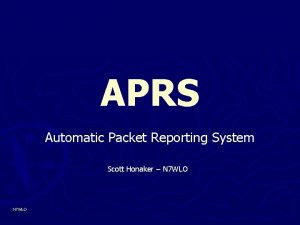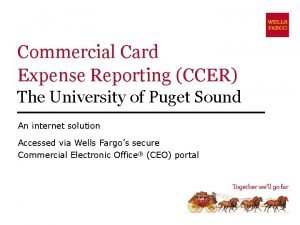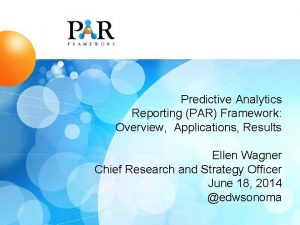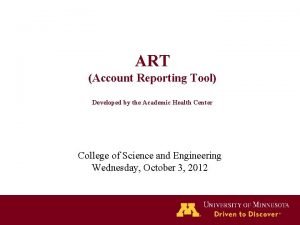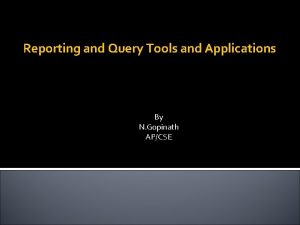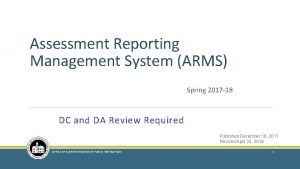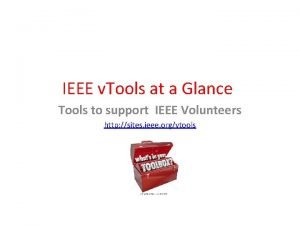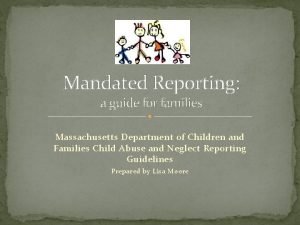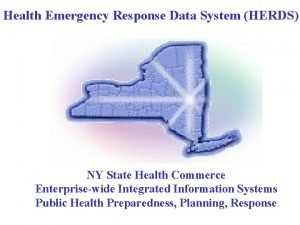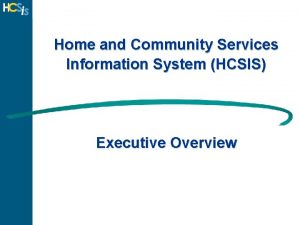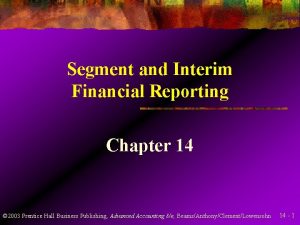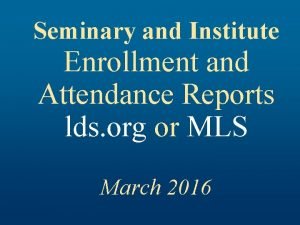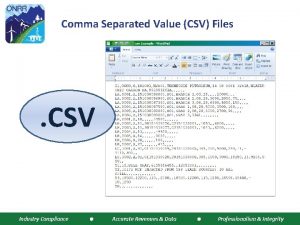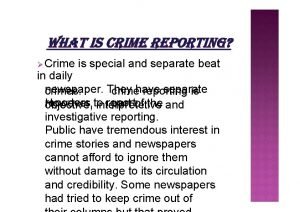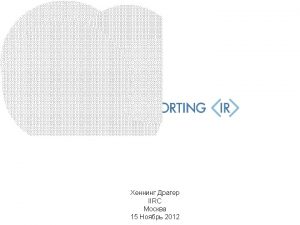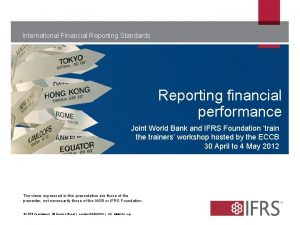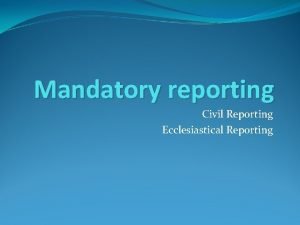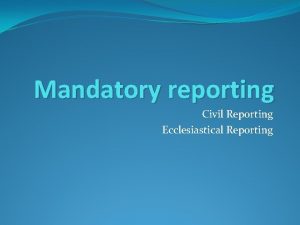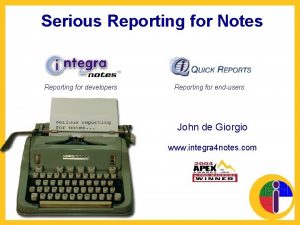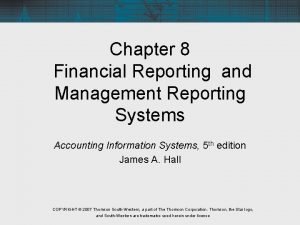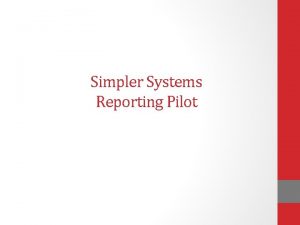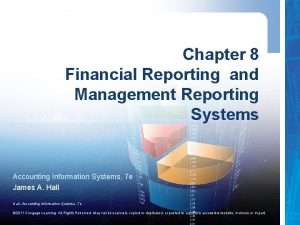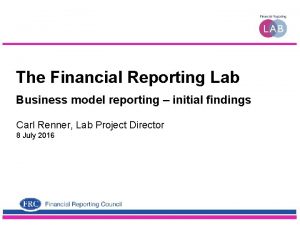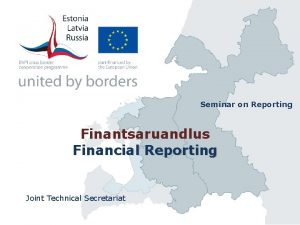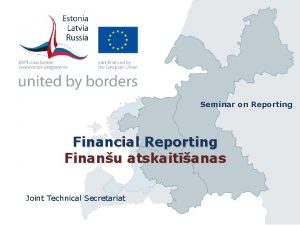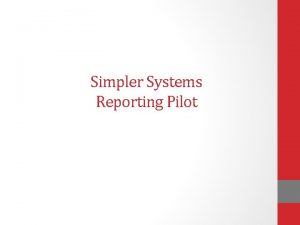Financial Reporting r e t u Fu 1





























































- Slides: 61

Financial Reporting r e t u Fu 1

Will it Revolutionize Financial Reporting? 2

AICPA Top Ten Technologies - 2003 3

Top Ten Technologies 2003 1. Information Security 2. Business Information Management 3. Application Integration 4. Web Services 5. Disaster Recovery Planning 4

Top Ten Technologies 2003 6. Wireless Technologies 7. Intrusion Detection 8. Remote Connectivity 9. Customer Relations Management 10. Privacy 5

AICPA Top Ten Technologies - 2002 6

Top Ten Technologies 2002 1. Business and Financial Reporting Applications 2. Training and Technology Competency 3. Information Security and Controls 4. Quality of Service 7

What is XBRL? 11

e. Xtensible. . . l Capable of being extended or protruded. l Of or relating to a programming language or a system that can be modified by changing or adding features. l e. Xtensible = Flexible 12

XBRL l XBRL is an XML-based framework that provides a standards-based method l to prepare, l publish in a variety of formats, l reliably extract and l automatically exchange financial statements of both public and private companies and the information contained within. 13

XBRL (From xbrl. org) l Provides an XML-based framework that the global business information supply chain can use to create, exchange, and analyze financial reporting information including, but not limited to. . . 14

XBRL. . . l Regulatory filings such as annual and quarterly financial statements. l General l Audit ledger information, and schedules. 15

XBRL. . . l XBRL is freely licensed and facilitates the automatic exchange and reliable extraction of financial information among various software applications anywhere in the world. 16

What is XML? e. Xtensible Markup Language 17

XML l “If HTML is the fire-engine red paint and supple leather interior of a sports car. . . l XML is the turbocharged engine and sport suspension. ” Michael Morrison. 18 Teach Yourself XML in 24 Hours

XML 19

e. Xtensible Markup Language l ……is a meta markup language the l considers a universal standard for describing both structured data and the behavior of applications that process the language. 20

VPML – Virtual Pet Markup Language <pets> <pet name=“Maximillian” type =“pot bellied pig” age=“ 3”> <friend name=“Augustus”/> <friend name=“Nigel”/> </pet> <pet name=“Augustus” type=“goat” age=“ 2”> <friend name=“Maximillian”/> </pet> <pet name=“Nigel” type=“chipmunk” age=“ 2”> <friend name=“Maximillian”/> </pets> Michael Morrison. 21 Teach Yourself XML in 24 Hours

HTML – XML Comparison l Sample l <H 3>Sale Price: $24. 95</H 3> <I>(Suggested retail: $39. 95)</I><B>Shipping cost: $4. 00 UPS Ground</B> l Sample l HTML Coding XML Coding <PRICE type=“sale” unit=“US Dollar”>24. 95 </PRICE> <PRICE type=“retail” unit=“US Dollar”>39. 95</PRICE><SHIPPING type=“UPS Ground” unit=“US Dollar”>4. 00</SHIPPING> 22

What Is XML? l “XML is a l platform-independent, l self-describing, l expandable, l standard data exchange format. ” 23

XML is Platform Independent l Windows l Unix l Macintosh l Mainframe l Linux 24

XML is Self-Describing l Example: l <DATE>July 26, 1998</DATE> l Describes the information, not the presentation l Format neutral 25

XML is Expandable l Whereas HTML has a fixed set of tags l l l <H 1>, <B>, <PRE> XML lets you create your own tags l <sugary-substance> l <Shakespearean-character> l <cash-equivalent> The key focus is on content, not presentation 26

XBRL Builds on XML and SGML XBRL Industry Developed, Supported 2001 W 3 C Supported XML and XML enabling technologies X-Link, X-Schema 1998 ISO Standard SGML Standard Generalized Markup Language 1986 27

What XML is Not!! l XML is Not l A religion. l The solution to all world problems. l A solution for all electronic commerce problems. l A solution to all legal-technology problems. 30

What is ‘XML’? l XML is a Tool l XML is a Really Cool (Powerful) Tool! l Like all tools, XML can be used wisely and unwisely. 31

Why is XML so Important? l Vendor neutral l Readable l More data format flexible and easier to use than EDI 32

Why is XML so Important? l All major software products are becoming “XML” enabled l Defacto standard for data exchange 33

XML l Widely expected to reduce cost of publishing to the Net by as much as 50%. l And by next year 70% of all B 2 B transactions executed on the Web will be done using XML. Gartner Group prediction 34

Who defines the tags? l Tags are defined by industry consortiums l Each industry’s standard tags are commonly referred to as a taxonomy 35

XBRL Taxonomies l Commercial and Industrial Companies, US GAAP - Published l Federal l Mutual Departments, US Funds, US l Financial Institutions, US l Commercial and Industrial, IASC 36

XBRL Taxonomies l Commercial and Industrial, German GAAP l Bank Call Reports - FDIC 37

Who’s Building Taxonomies? Accounting Advertising Architecture Automotive Banking Communication Economics Education E-Commerce EDI ERP Financial Healthcare HR Insurance Legal Music News Publishing Real Estate Retail Science Software Supply Chain 38

Industry Specific Context Auto Industry Chemical Publishing or Mythology Music <CAR-MODEL> <SYMBOL> <GOD> <RECORDLABEL> Aerospace <PROGRAM> Astronomy <PLANET> 39

HTML, XML, and XBRL? How do they differ? 40

HTML l In simple terms, HTML is a system of marking up a document so it can be published on the WWW. l Documents prepared in HTML contain reference graphics and formatting tags. 41

HTML l HTML is a series of pre-defined tags that primarily focus on describing how content appears on the Internet. l HTML describes what font, font size, and color the text of this paragraph should be when viewed via a web browser. 42

HTML l With HTML you have a lot of content but no real context. l That is where XML comes in. 43

e. Xtensible Markup Language l XML is the universal format for data on the web that uses tags to give context and structure to content. l XML is a standards language ratified in February 1998 and maintained by the World Wide Web Consortium (W 3 C). 44

e. Xtensible Markup Language l XML does not replace HTML – it is a complimentary format that is platform independent, allowing XML data to be rendered on any device, such as a computer, cell phone, PDA or tablet device. 45

e. Xtensible Markup Language l XML allows developers to easily describe and deliver rich, structured data from any application in a standard, consistent way. 46

e. Xtensible Markup Language l Whereas HTML offers a fixed/predefined number of tags. . . l XML neither defines nor limits tags. l XML provides a framework for defining tags (taxonomy) and the relationship between them (i. e. , schema). 47

l XBRL is an XML-based schema that focuses specifically on business reporting. l XBRL is a complement to XML, allowing accountants and regulatory bodies to identify items that are unique to the business reporting environment 48

l XBRL’s schema defines how to create XBRL documents and XBRL taxonomies (i. e. , GAAP, IAS), l Providing a set of business information tags that allows users to identify business information in a consistent format. 49

l XBRL is also extensible in that users are able to create their own XBRL taxonomies that define and describe tags unique to a given environment. 50

XBRL: How It Can Improve Today’s Business Environment 58

Case 1: Consolidating Subsidiaries - Now l Consolidated quarterly financial statements. l 100 Subsidiaries l 3 -14 days to produce first draft financial statement for internal use. l 7 -45 days to generate external financial statement. 59

Case 1: Consolidating Subsidiaries – Under XBRL l XBRL can be “least common denominator. ” l Closing l SEC process can be XBRL-ized. filings can be XBRL-ized 60

Case 2: Issuing Financial Statements - Now l Large company with 30 separate mutual funds in its family of funds. l Each fund distributes quarterly financial statements. l Each report manually modified to prepare printed output. l Analysis of information difficult. 61

Case 2: Issuing Financial Statements – Under XBRL l Automate the process of generating financial statements. l Expedite the process of creating HTML Web Pages to display information. l Facilitate the analysis of information in the 30 financial statements. l Reduce production & distribution costs. 62

Case 3: Following Government Regulations - Now l Form 990 (Organization Exempt From Income Tax). l Multistep process l $5, 000 per year to key in information for the 230, 000 organizations. l Keying error rate of 1% = 920, 000 errors. 63

Case 3: Following Government Regulations – Under XBRL l XBRL-ize the process. . . l No cost to have the Forms 990 of 230, 000 charitable organizations available to everyone in electronic form. l Error rate of rekeying information is now 0%. 64

Finally, Business Talks the Same Language Stanley Zarowin and Wayne E. Harding August 2000 65

What is XBRL Used For? 66

What is XBRL Used For? l XBRL, at least at first, will be used to publish digitally companies’ financial statements for external users. l An XBRL-based F/S is a digitally enhanced version of paper-based F/S which includes the complete “set” of F/’S including the accountant’s report. 67

Potential XBRL Applications 68

Potential XBRL Applications l Financial Statements l Taxes l Regulatory Filings l Accounting and Business Reports l Authoritative Literature. 69

What are the benefits of XBRL for Financial Statements? 70

XBRL Benefits l Preparing a financial statement for l Printing l A Web Site l Regulatory filing l Means potentially entering information three times. 71

XBRL Benefits l With XBRL, information will be entered once and the same information will be “rendered” l As a printed Financial Statement l As an HTML document for a Web Site l As an EDGAR filing l As a raw XML file l As some specialized reporting format 72

Financial System XBRL-enabled Financial Statements Drill Down Transaction Details 73
 Objectives of financial reporting
Objectives of financial reporting Accounting and audit board of ethiopia
Accounting and audit board of ethiopia Limitations of financial reporting
Limitations of financial reporting Intermediate accounting chapter 2
Intermediate accounting chapter 2 Fair value historical cost
Fair value historical cost Cbd financial reporting framework
Cbd financial reporting framework Purpose of financial reporting
Purpose of financial reporting Corporate financial reporting and analysis
Corporate financial reporting and analysis Accounting rules
Accounting rules Ias 34 interim financial reporting
Ias 34 interim financial reporting What is financial reporting studio?
What is financial reporting studio? International financial reporting standards 9
International financial reporting standards 9 Chapter 2 conceptual framework for financial reporting
Chapter 2 conceptual framework for financial reporting What is financial reporting studio?
What is financial reporting studio? Frxdesigner
Frxdesigner Project management financial reporting
Project management financial reporting Hyperion foundation services
Hyperion foundation services Limitations of financial reporting
Limitations of financial reporting Financial methods of motivation definition
Financial methods of motivation definition Public speaking in business communication
Public speaking in business communication National deworming day
National deworming day Nextgen crystal report
Nextgen crystal report Of what value is the weather depiction chart to the pilot?
Of what value is the weather depiction chart to the pilot? Calxa reporting
Calxa reporting Periodic report structure
Periodic report structure Georgia coam
Georgia coam Microsoft project server reporting
Microsoft project server reporting Microsoft spla reporting software
Microsoft spla reporting software Acc structured reporting
Acc structured reporting Pama reporting 2019
Pama reporting 2019 Variable costing and segment reporting tools for management
Variable costing and segment reporting tools for management Hotel competitive set
Hotel competitive set Segment reporting introduction
Segment reporting introduction Variable costing and segment reporting tools for management
Variable costing and segment reporting tools for management Gpa scale reporting
Gpa scale reporting Progression point scale victorian curriculum
Progression point scale victorian curriculum Dppc mandated reporting
Dppc mandated reporting Selfservice bi
Selfservice bi Pennsylvania new hire reporting
Pennsylvania new hire reporting Spill reporting requirements by state
Spill reporting requirements by state Reporting aggregated data using the group functions
Reporting aggregated data using the group functions Secrtariat
Secrtariat Serea consulting
Serea consulting Aprspoint
Aprspoint Pa child abuse reporting
Pa child abuse reporting Commercial card expense reporting
Commercial card expense reporting Predictive analytics reporting (par) framework
Predictive analytics reporting (par) framework Missouri unclaimed property reporting
Missouri unclaimed property reporting A reporting tool art
A reporting tool art Standard business reporting programma
Standard business reporting programma Reporting and query tools
Reporting and query tools Arms reporting system
Arms reporting system Vtools officer reporting
Vtools officer reporting Mandated reporter massachusetts
Mandated reporter massachusetts Tn mandatory reporting laws
Tn mandatory reporting laws Herds reporting
Herds reporting Hcsis
Hcsis Segment and interim reporting chapter 8
Segment and interim reporting chapter 8 Up to date reporting speech
Up to date reporting speech Lcr lds
Lcr lds Ogor reporting
Ogor reporting Beat reporting definition
Beat reporting definition
